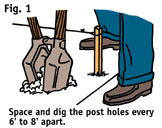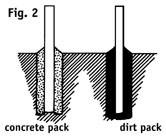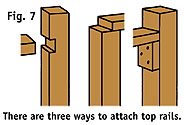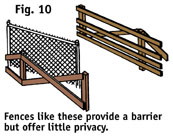 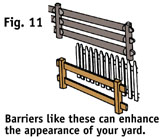
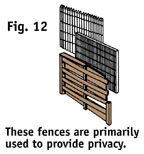
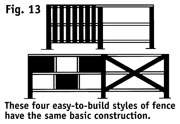
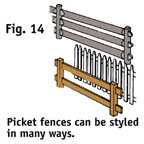

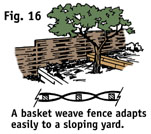
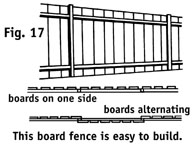
|

SELECTING THE FENCE STYLE
- There are literally hundreds of variations in fence styles and construction materials.
There is pre-assembled wood fencing sections as well as fencing materials made from
recycled milk jugs. The type of fence you use depends primarily on the purpose.
- Fences like the type shown in Fig. 10 are used primarily for barriers. They are easy to
build and provide an adequate barrier. However, they are usually not very decorative and
they provide very little, if any, privacy.
- Fences like those illustrated in Fig. 11 provide barriers and are more attractive than
an ordinary fence. With a little shrubbery or plants, such fences can provide very
attractive barriers along property lines.
- Fences such as those illustrated in Fig. 12 are primarily privacy screens. They can be
built as tall as needed out of many different materials. Their primary purpose is privacy.
- Consider your needs when selecting the style of your fence. If you want a simple
barrier, a wire fence or a simple style fence such as illustrated in Fig. 10, will work
fine.
- For a barrier that enhances the appearance, consider styles similar to those illustrated
in Fig. 11.
- For added privacy, consider the styles illustrated in Fig. 12.
- Regardless of the type of fence you plan to build, be sure you know exactly where your
property line is located. If you are uncertain about the location of the line, check into
it or work out an agreement on the fence location with your neighbor.
- Also, check any local ordinances applying to fences before beginning construction. Call
the building department of your local city hall or ask for the local government office
that regulates construction to be sure you abide by city codes.
- Try to keep the bottom rail of any fence at least 2" above the ground. This helps
eliminate the problem of decay and makes it easier to trim grass around the base of the
fence.
- Fig. 13 illustrates four basic styles of easy-to-build fence. Each style has the same
basic top, center and bottom rail construction. However, the fences look entirely
different with the various rail treatments.
- Study the designs in Fig. 13 carefully. Decide which of these styles you prefer, or use
a little imagination and create your own fencing design to apply to the basic rail fencing
structure.
- Picket fences are very popular and easy to build. With a little ingenuity you can create
attractive picket designs. Study the designs in Fig. 14. Use the designs shown in Fig. 14
or your own designs to create a distinctive picket fence.
- Make sure that all the pickets are spaced by inserting a loose picket between the picket
previously nailed into position and the picket to be nailed. Use this easy method
throughout the entire fencing construction.
- A basket weave fence is often used on a sloping terrain (Fig. 16). This style of fence
allows you to raise or lower each post.
- Use a good-quality board to build a basket weave fence. Boards full of knots may break
easily when placed under the stress of basket weaving.
- A simple board fence is easy to build and can be quite attractive (Fig. 17). You can
place the boards on one side or alternate them from side to side.
- The board fence provides both a barrier and privacy. It can be built as tall as needed
and then stained, painted or left natural.
- You can design a siding fence to match the siding on your home of this style. In fact,
you can use the same siding that was used on the home to build the fence.
- The siding fence can be covered on one side or both. Then, you can paint it to match or
harmonize with the paint on your home.
- These are only a few of the many styles of fencing available. Fences are easy to build,
and the materials are readily available.
|




